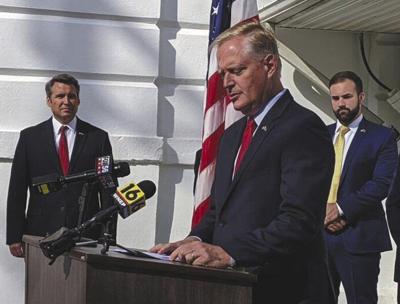lected officials and public relations experts love talking points, as long as those delivering them stick to the message and the intended audience doesn’t delve deeper beyond the one- or two-sentence sound bite.
In the days leading up to and in the ensuing weeks since the $1.9 trillion American Rescue Plan was passed in late February, Republican lawmakers pounded the pavement by noting the bill isn’t a COVID relief bill, but is littered with agenda items Democrats have been unable to push through until now. The number GOP members roll out is that between nine and 10 percent of the Rescue Plan funding is COVID related, the rest is Democratic pork.
“This is not a COVID bill. This is not a rescue plan. This is the last train leaving that Democrats can plausibly contend is a COVID bill,” Sen. Pat Toomey, a Republican from Pennsylvania, said. “This is a long-standing liberal wishlist.”
In a town hall this week, Rep. Fred Keller said “90 percent of the bill has nothing directly targeted to COVID.” In a commentary published in The Daily Item just before the bill was passed, Keller wrote “President Biden and Washington Democrats’ latest $1.9 trillion stimulus package focuses more on fulfilling partisan priorities than combating COVID-19.”
We get that there are numerous ways to interpret data, to spin something to fit into a narrative you prefer. So, here is our interpretation and whether the funds are “COVID related” or not. According to the Committee for a Responsible Federal Budget, a nonpartisan, non-profit organization committed to educating the public on issues with significant fiscal policy impact:
•$15 billion is to increase nutrition assistance, purchase and distribute food to needy individuals, and pay off loans for socially disadvantaged farmers.
•$17 billion is to fund health services and facilities for veterans and fund job assistance training programs for veterans.
•$49 billion goes to fund the Small Business Credit initiative, provide mortgage assistance, and to assist the homeless.
•$78 billion is to fund disaster relief, cover funeral expenses related to COVID, provide grants to transit agencies and communities under economic stress.
•$279 billion goes to funding for education from K-12 to college-level, to provide support for child care, child care providers and Head Start, subsidize health care coverage for laid-off workers and extend nutrition existence for school lunches.
•$825 billion goes to stimulus checks, extending unemployment benefits, extending tax credits for children and child care and paid sick leave.
Just those items add up to $1.26 trillion, or about two-thirds of the total spending plan. This list also does not include funds to push COVID testing and vaccinations and PPE programs.
We would argue each and every one of those items has been impacted by COVID-19, and likely will be impacted for a significant period. Employers and employees have been impacted. School budgets and students have been impacted.
Are some items in the bill pork? Yes. Funding pension plans and forcing the minimum wage into the bill seem like a reach. But saying that 90 percent of the money is a waste is just not true.
— The (Sunbury) Daily Item















(0) comments
Welcome to the discussion.
Log In
Keep it Clean. Please avoid obscene, vulgar, lewd, racist or sexually-oriented language.
PLEASE TURN OFF YOUR CAPS LOCK.
Don't Threaten. Threats of harming another person will not be tolerated.
Be Truthful. Don't knowingly lie about anyone or anything.
Be Nice. No racism, sexism or any sort of -ism that is degrading to another person.
Be Proactive. Use the 'Report' link on each comment to let us know of abusive posts.
Share with Us. We'd love to hear eyewitness accounts, the history behind an article.